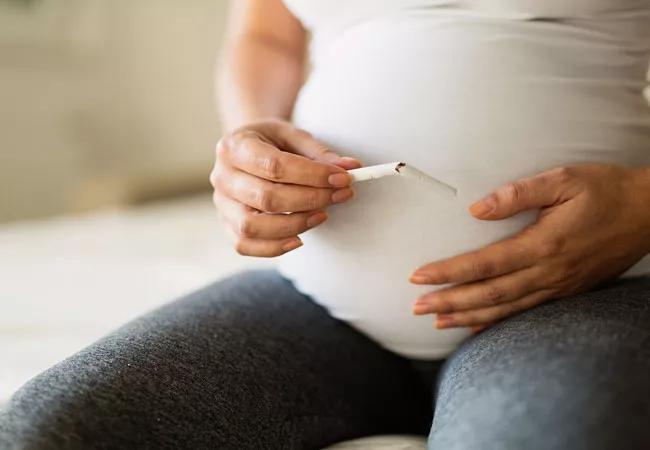Despite knowledge of risks, 10% of women smoke at some point during their pregnancies

Advertisement
Cleveland Clinic is a non-profit academic medical center. Advertising on our site helps support our mission. We do not endorse non-Cleveland Clinic products or services. Policy
A recent study suggests that 22% of sudden, unexpected infant deaths (SUIDs) in the United States may be attributed to maternal smoking during pregnancy.
This latest study analyzed 20,685,463 live births and 19,127 SUIDs from 2007 through 2011 in an effort to determine the effects of maternal smoking by trimester and daily cigarette consumption, pre-pregnancy smoking levels, reduction or cessation of smoking during pregnancy and ICD-10 codes for cause of infant death.
Any amount of smoking during pregnancy – even one cigarette – doubles the risk of SUID. For mothers who smoke 1-20 cigarettes per day, each additional cigarette increased the chance of SUID by 0.7 times. For example, a woman who smokes 15 cigarettes per day has a threefold chance of her infant dying from SUID.
Maternal smoking is an established risk factor of SUID. In fact, although the risks of smoking during pregnancy seem fairly well acknowledged, 10% of pregnant women smoked during the last three months of their pregnancies in 2011. In the US, more than 3,700 infants die each year from SUID, which includes sudden infant death syndrome, accidental suffocation and strangulation in bed, and ill-defined causes. In 2017, 19.4%-22.8% of adults in the Ohio indicated they were current smokers, according to the Centers for Disease Control. Across the nation, 12 out of every 100 women were smokers.
Quitting smoking results in the greatest reduction in SUID risk; but every cigarette that can be reduced counts. Mothers who smoked in the three months prior to pregnancy, and quit in the first trimester, still had a 50% greater chance of a SUID death compared to nonsmokers.
Advertisement
Screening pregnant women for smoking habits should begin at the very first prenatal visit, and should continue throughout the prenatal period. As physicians, we rely on self-reporting for substance use, including smoking, alcohol and drugs.
I advise patients of the risks of smoking – risks to themselves, but, more importantly, risks to their unborn child. I tell them to consider all of those risks and to plan ahead when quitting. Patients need to change the environment that puts them at risk, recognize the triggers (whether stress, habit or social triggers) and make sure their loved ones are aware and supportive of their decision to quit. I counsel the significant other (assuming they attend the first OB appointment or subsequent appointments) in the hopes that they will recognize the risks and will want to help. I tell them that once they’ve given up smoking, they cannot “just have one” because they will find suddenly they are back to smoking a pack per day.
Providing patient education about the risks inherent in smoking during pregnancy may serve to motivate behavioral change; however, some patients may need counseling or other interventions. The American College of Obstetricians and Gynecologists recommends the use of nicotine replacement therapies, under close supervision, if women are unable to quit on their own or with counseling. Buproprion is also used to help with smoking cessation, and is safe in pregnancy. The National Cancer Institute’s Smokefree Women initiative may also help women stay motivated and find support as they attempt to quit smoking. Additionally, we provide an extensive list of resources to pregnant women who smoke, including the Cleveland Clinic Tobacco Treatment Center, the National Cancer Institute, the American Lung Association and the American Cancer Society.
Advertisement
Advertisement

ACOG-informed guidance considers mothers and babies

Prolapse surgery need not automatically mean hysterectomy

Artesunate ointment shows promise as a non-surgical alternative

New guidelines update recommendations

Two blood tests improve risk in assessment after ovarian ultrasound

Recent research underscores association between BV and sexual activity

Psychological care can be a crucial component of medical treatment

A multidisciplinary approach facilitates timely diagnosis and better treatment